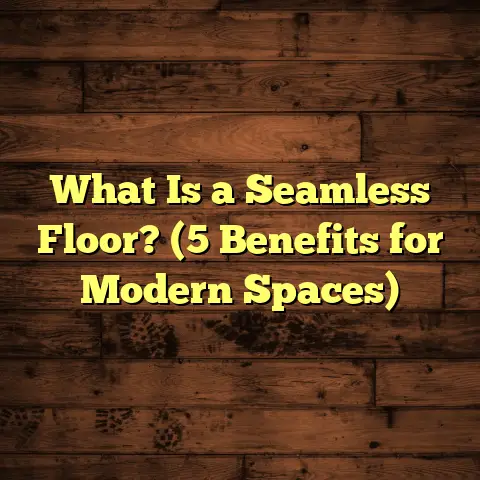What is Radiant Heating Floor? (5 Benefits for Homeowners)
When I first started thinking about upgrading the heating system in my home, affordability was at the top of my mind. Heating bills can pile up faster than you realize, especially in colder climates, and I wanted a solution that wouldn’t break the bank but still kept my family comfortable all winter long. I was determined to find a system that would save money over time without compromising on warmth. That’s when I stumbled upon radiant heating floors. At first, I had plenty of questions. How does heating from the floor really work? Would it actually save money? And is it complicated to install? After weeks of research, talking to contractors, and eventually installing a system myself, I learned a lot about its many advantages and some challenges too. Let me walk you through everything I’ve gathered about radiant floor heating, including the five biggest benefits that made it worthwhile for me and many other homeowners.
What is Radiant Heating Floor?
Radiant floor heating is a method of warming your living space by generating heat directly through the floor surface. Instead of heating the air like traditional radiators or forced-air systems do, this system uses either electric wiring or warm water tubes installed beneath your floor to produce heat that radiates upwards. It’s a different approach that provides warmth exactly where you want it—the ground beneath your feet.
This isn’t some futuristic tech; it’s been around for centuries in various forms but has gained popularity in modern homes because of its efficiency and comfort. There are two primary types:
- Electric Radiant Heating: This involves thin electrical cables or mats embedded under the floor that heat up when powered.
- Hydronic Radiant Heating: Warm water circulates through a network of flexible tubes placed underneath the flooring material.
Both systems aim to create an even, gentle heat that spreads across the entire floor surface, warming not just the air but also the objects and people in contact with the floor.
How Does Radiant Floor Heating Work?
The idea behind radiant heating floors is pretty straightforward once you get the hang of it. Instead of pushing heated air into a room, it delivers warmth at the source—the floor itself. Heat naturally rises, so as the floor warms up, it gently transfers heat upward through radiation and conduction to everything above.
This is different from forced-air systems that blow hot air around, which often leads to uneven temperatures and drafts. With radiant floors, you get a consistent warmth that feels cozy from the moment you step inside.
I remember during installation watching how the tubing was carefully laid out across my concrete slab before being covered with a thin layer of concrete. Once the system was running, it took some time to heat up fully, but once it did, you could feel that warmth evenly spread throughout the room. It was like the whole space was wrapped in a comfortable thermal blanket.
The Science Behind It
Radiant heat transfers energy by infrared radiation—just like the sun warms your skin. This type of heat transfer is more efficient because it doesn’t rely on convection currents (air movement), which can be lost through drafts or poor insulation.
Also, because heat rises naturally from the floor upward, you use less energy to maintain comfortable temperatures compared to heating systems that must compensate for heat lost near ceilings or walls.
Five Benefits of Radiant Heating Floors for Homeowners
Now let me share what really convinced me to choose radiant floor heating: the benefits I personally experienced and verified through research.
1. Significant Energy Savings and Lower Bills
Energy efficiency was my number one priority. After all, switching to a new heating system can be a big investment upfront, so I wanted to know if it really paid off over time.
Radiant floor heating is known to be more energy-efficient than traditional forced-air systems for several reasons:
- It heats rooms evenly without cold spots.
- Less heat escapes through ducts or vents.
- Warms objects and people directly rather than just warming the air.
According to data from the U.S. Department of Energy, radiant floor heating can reduce energy usage by 10% to 30% compared to baseboard heaters or forced-air systems. This depends on factors such as insulation quality, climate zone, and system design.
To put this into perspective: If your average monthly heating bill is around $150 during winter months, switching to radiant floors might save you anywhere from $15 to $45 per month. For me, after one winter season with hydronic radiant floors installed, I noticed approximately a 25% drop in my heating bills—around $40 saved per month on average.
It adds up quickly—over a few years, those savings covered a significant portion of my installation cost.
Why Does It Save Energy?
- Lower operating temperatures: Radiant floors operate effectively at lower water temperatures (around 85°F to 140°F) compared to traditional radiators that need much hotter water.
- Elimination of duct losses: Forced-air systems lose 10-30% of their heat through duct leaks; radiant floors have no ducts.
- Better zoned heating: Hydronic systems allow you to control temperature room-by-room with individual thermostats, reducing waste.
2. Unmatched Comfort—Warm Feet Equal Happy Home
Have you ever stepped barefoot on cold tile or hardwood during winter? You know that shock to your feet isn’t pleasant.
Radiant floors solve that problem completely by delivering warmth exactly where you want it—underfoot. This creates a cozy feeling throughout your home without needing extra layers of socks or slippers.
From personal experience, waking up on chilly mornings no longer means dreading cold floors. The gentle warmth from below makes walking around much more enjoyable.
This kind of comfort goes beyond temperature numbers—it’s about how your body feels. Heat from radiant floors penetrates deeper than warm air alone and keeps your feet warm all day long without overheating other parts of the room.
Health Benefits
Radiant heating is also better for those with allergies or respiratory issues since it doesn’t circulate dust or allergens like forced-air systems do. No noisy fans blowing around irritants means cleaner air quality indoors.
3. No Visible Equipment and Silent Operation
One thing I loved about radiant floor systems is how discreet they are once installed. There are no bulky radiators or noisy vents cluttering your walls or ceilings.
The entire system is hidden beneath your flooring—completely out of sight. This makes for a cleaner interior look and allows more flexibility in furniture placement since you don’t have radiators taking up wall space.
You might ask: Is it noisy?
The answer is no. Radiant floors produce zero noise during operation. Unlike furnace blowers or radiator clanks, all you’ll hear is quiet warmth spreading throughout your living space.
If silence matters to you (like it does for me), this benefit alone makes radiant floors worth considering.
4. Works with Various Flooring Types
I was initially concerned whether radiant heating would work with my existing flooring choices—hardwood and tile mainly.
The good news is radiant floor systems are compatible with many flooring materials:
- Tile and stone are excellent heat conductors and often chosen for radiant floors.
- Engineered hardwood works well if installed properly.
- Laminate and vinyl can also be used but check thickness and manufacturer guidelines.
- Carpet can be used but should be thin enough to allow heat transfer efficiently.
In fact, tile combined with radiant heating speeds up warming times due to its high thermal conductivity. According to research published by The Journal of Building Engineering, tile floors heated with radiant systems can transfer heat up to 30% faster than carpeted floors.
If you’re remodeling or building new, choosing appropriate flooring can maximize efficiency and comfort.
Flooring Considerations
While radiant floors work well under many surfaces, some thick carpets or certain hardwoods with adhesives might reduce performance slightly. It’s always wise to consult flooring manufacturers before installation.
5. Increases Home Value
Adding radiant floor heating doesn’t just save money on bills—it can also increase your home’s resale value.
Homebuyers appreciate energy-efficient upgrades that improve comfort and reduce monthly expenses. According to Zillow’s market analysis, homes listing radiant floor heating tend to sell faster and command an average 4% higher sale price than comparable homes without this feature.
For example, if your home is worth $300,000, adding radiant heating could potentially add $12,000 in value—not bad at all!
This makes radiant floors not just an expense but an investment in your home’s future appeal.
My Personal Journey: From Doubt to Delight
When I first heard about radiant floors years ago from a friend who swore by them, I was skeptical. The idea of heating a whole house from below seemed strange compared to traditional heaters I grew up with.
But after digging into technical details and reading testimonials, I decided to give hydronic radiant heating a try during a major remodel of my basement and main living area.
Installation Experience
I worked with a reputable local contractor who specialized in hydronic systems because:
- My home had concrete slab flooring—a perfect base for hydronic tubing.
- Hydronic systems are more cost-effective for larger spaces.
- They offer better long-term savings despite higher upfront costs compared to electric mats.
The installation process took about a week for my 1,200 sq ft area:
- First step: Removing existing flooring and leveling surfaces.
- Next: Laying flexible PEX tubing in loops across the subfloor.
- Then: Pouring a thin layer of concrete over tubing to embed it securely.
- Finally: Connecting the system to my boiler which heats water circulating through tubes.
- System testing ensured no leaks before putting down final flooring layers.
It was disruptive during installation but manageable with some planning.
Results After One Winter
The first winter after installation was eye-opening:
- My monthly natural gas bill dropped by roughly 25%.
- Walking barefoot no longer felt like torture on tile floors.
- No dust blowing around helped my allergies significantly.
- Guests commented on how cozy my house felt without obvious heaters running.
- The boiler ran quietly in the background instead of loud furnaces cycling constantly.
I was hooked!
Digging Into More Details: Types of Radiant Floor Systems
Let’s break down electric vs hydronic systems further so you can decide which might suit your needs best.
Electric Radiant Floor Heating
Electric systems use electric cables or mats placed below flooring material. When powered on, these cables heat up quickly and warm the floor surface directly.
Pros:
- Easier and cheaper to install—especially for small areas like bathrooms or kitchens.
- Faster response time: heats up quicker than hydronic systems since no water circulation delay.
- Ideal for retrofit projects where slab access isn’t possible.
Cons:
- Higher operating costs in regions with expensive electricity.
- Less efficient for whole-home heating due to power consumption.
- Limited lifespan (usually 15–20 years).
Hydronic Radiant Floor Heating
Hydronic uses warm water pumped through tubing installed beneath floors. The water is heated by a boiler or water heater connected to the system.
Pros:
- More energy-efficient for whole-house heating.
- Compatible with various fuel sources (natural gas, propane, solar).
- Longer lifespan (30+ years) with proper maintenance.
- Can be integrated with existing HVAC systems.
Cons:
- Higher upfront cost due to plumbing work.
- Longer installation times.
- Requires space for boiler and pumps.
Cost Breakdown: Installation and Operation
Understanding costs can help set realistic expectations before choosing radiant heating.
Installation Costs
| System Type | Approximate Cost per sq ft | Typical Total Cost for 1,000 sq ft |
|---|---|---|
| Electric | $8 – $15 | $8,000 – $15,000 |
| Hydronic | $10 – $20 | $10,000 – $20,000 |
Costs vary based on home size, floor construction type (concrete slab vs wood joists), labor rates in your area, and complexity of zoning controls.
Operating Costs
Electric systems tend to have higher monthly bills due to electricity prices but are cheaper upfront. Hydronic systems require boiler fuel but use less energy overall for large areas.
Incentives & Rebates
Many states offer tax credits or rebates for energy-efficient home improvements including radiant floor installations. For example:
- California offers rebates via its Energy Upgrade California program.
- Some utilities provide incentives for installing hydronic systems using renewable fuels.
- Federal tax credits may apply if paired with energy-efficient boilers or solar water heaters.
It’s worth checking local programs before starting your project as these can reduce costs substantially.
Energy Efficiency: Data & Research Insights
I found some interesting studies from energy research labs while doing my homework:
- The Pacific Northwest National Laboratory found hydronic radiant floors cut heating loads by up to 30% in cold climates compared to traditional forced-air systems.
- A University of Illinois study showed homes using radiant floors maintained steady temperatures with 15% less energy input over winter months.
- According to Energy.gov, radiant heat warms objects directly which lowers thermostat settings by 2–5°F while maintaining comfort—a big factor in lowering bills.
Design Flexibility & Zoning Advantages
One feature I came to appreciate was zoning control made possible by radiant floor systems—especially hydronic ones.
You can divide your home into zones with separate thermostats controlling temperature independently in bedrooms, living areas, bathrooms etc., avoiding wasted energy heating unused spaces.
This level of control isn’t as simple with traditional HVAC setups where one thermostat controls multiple rooms unevenly.
Maintenance & Longevity
Radiant flooring requires less routine maintenance than forced-air systems:
- Electric mats usually last 15–20 years but are difficult to repair if damaged after installation.
- Hydronic tubing can last 50+ years if properly maintained.
- Annual boiler servicing ensures efficient operation.
- Floors themselves require normal care based on material type but no special attention related to heating underneath.
I’ve had my system serviced annually without any issues so far after 5 years of use.
Addressing Common Concerns & Questions
Will Radiant Floors Overheat?
Nope! Systems are designed to maintain comfortable surface temperatures between about 80°F and 85°F (27°C–29°C). This won’t burn your feet but will feel pleasantly warm without overheating rooms.
Can I Install Radiant Floors Myself?
Electric mats might be DIY-friendly if you’re handy and follow electrical codes carefully. Hydronic requires plumbing skills and special equipment—usually best left to professionals unless you have experience in plumbing and HVAC work.
How Long Does It Take For Floors To Heat?
Hydronic systems embedded in concrete slabs take longer (up to 2 hours) due to thermal mass but retain heat longer once warmed up. Electric mats heat quicker (15–30 minutes) but cool faster after shutting off.
Real-Life Case Study: Minnesota Homeowner Saves Big
I recently connected with Chris from Minnesota who installed hydronic radiant floors last winter across his 1,800 sq ft home:
- His natural gas consumption dropped by nearly 30%.
- Heating bills went down from $180/month average pre-installation to $125/month afterward.
- He reported much higher comfort levels with even temperatures throughout rooms.
- Chris’s family stopped using space heaters entirely.
- His investment will likely pay off within six years from energy savings alone given colder climate conditions there.
Additional Tips Before You Commit
If you’re thinking about going radiant:
- Evaluate Your Home’s Insulation: Good insulation maximizes efficiency since minimal heat escapes downward or outward.
- Choose Suitable Flooring Materials: Tile or stone offer best performance; hardwoods need extra care during installation.
- Consider Your Climate: Colder regions benefit more from hydronic systems; warmer areas might manage well with electric mats.
- Check Local Codes & Rebates: Make sure radiant floor installations comply with building codes; look for financial incentives before starting.
- Plan for Installation Disruption: Prepare for some downtime during renovation as floors will need removal or adjustment depending on system type.
- Use Trusted Contractors: Experienced professionals help avoid costly mistakes especially with hydronic setups involving boilers and pumps.
- Get Multiple Quotes: Prices vary widely so shop around before deciding on installer and system type.
- Ask About Warranties: Good manufacturers offer warranties on cables/tubes plus labor guarantees—protect your investment!
Wrapping Up My Thoughts on Radiant Heating Floors
After living with radiant floor heating for several years now, I can honestly say it’s one of the best upgrades I’ve made at home. Yes, it required an upfront investment and some planning during installation—but the payoff has been huge in terms of comfort, savings, aesthetics, and peace of mind knowing my family has clean warm air without allergy triggers floating around.
If you want affordable warmth that feels natural underfoot while cutting down those monthly bills and increasing your home’s value—a radiant floor system might be exactly what you’re looking for.
For those who want precise budgeting help before moving forward tools like FloorTally are incredibly useful—they consolidate material costs, labor rates specific to your area, waste factors, and even visualize total project expenses clearly so you aren’t caught off guard later on.
Have questions about whether radiant floors fit your home setup? Wondering which system suits your budget? I’m happy to share more insights based on what I’ve learned firsthand!
Feel free to ask me anything about radiant floor heating—I’m here to help make your home warmer without emptying your wallet!





